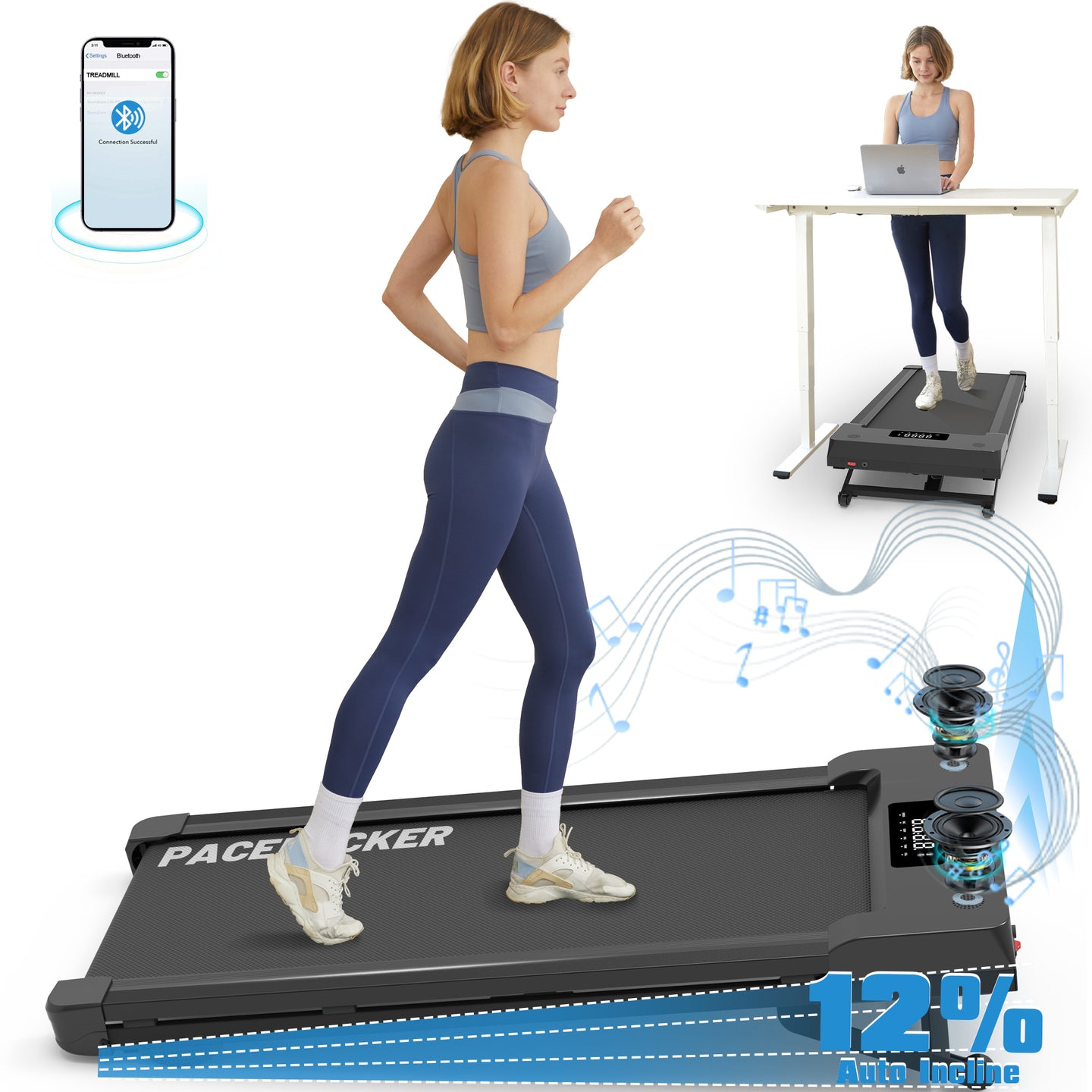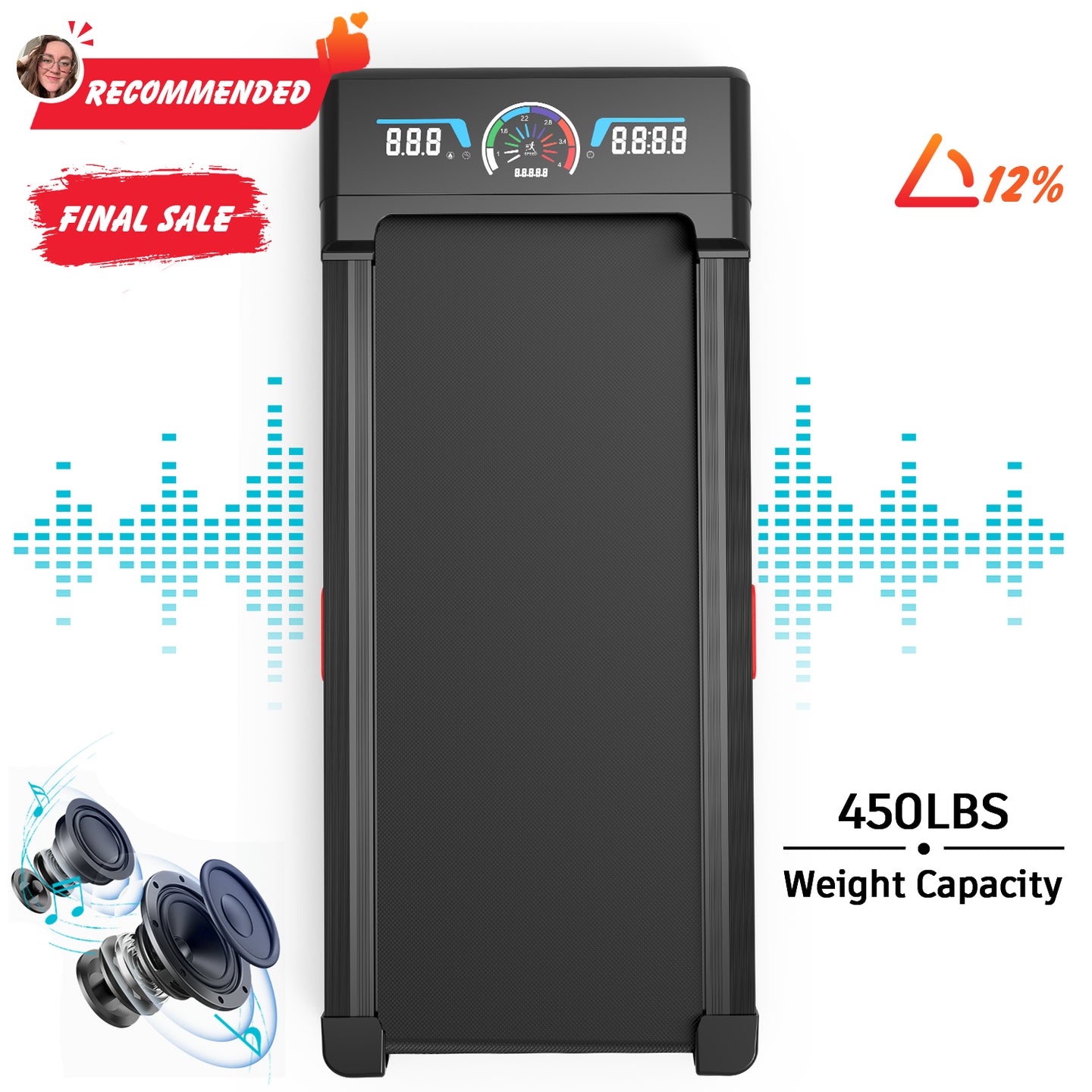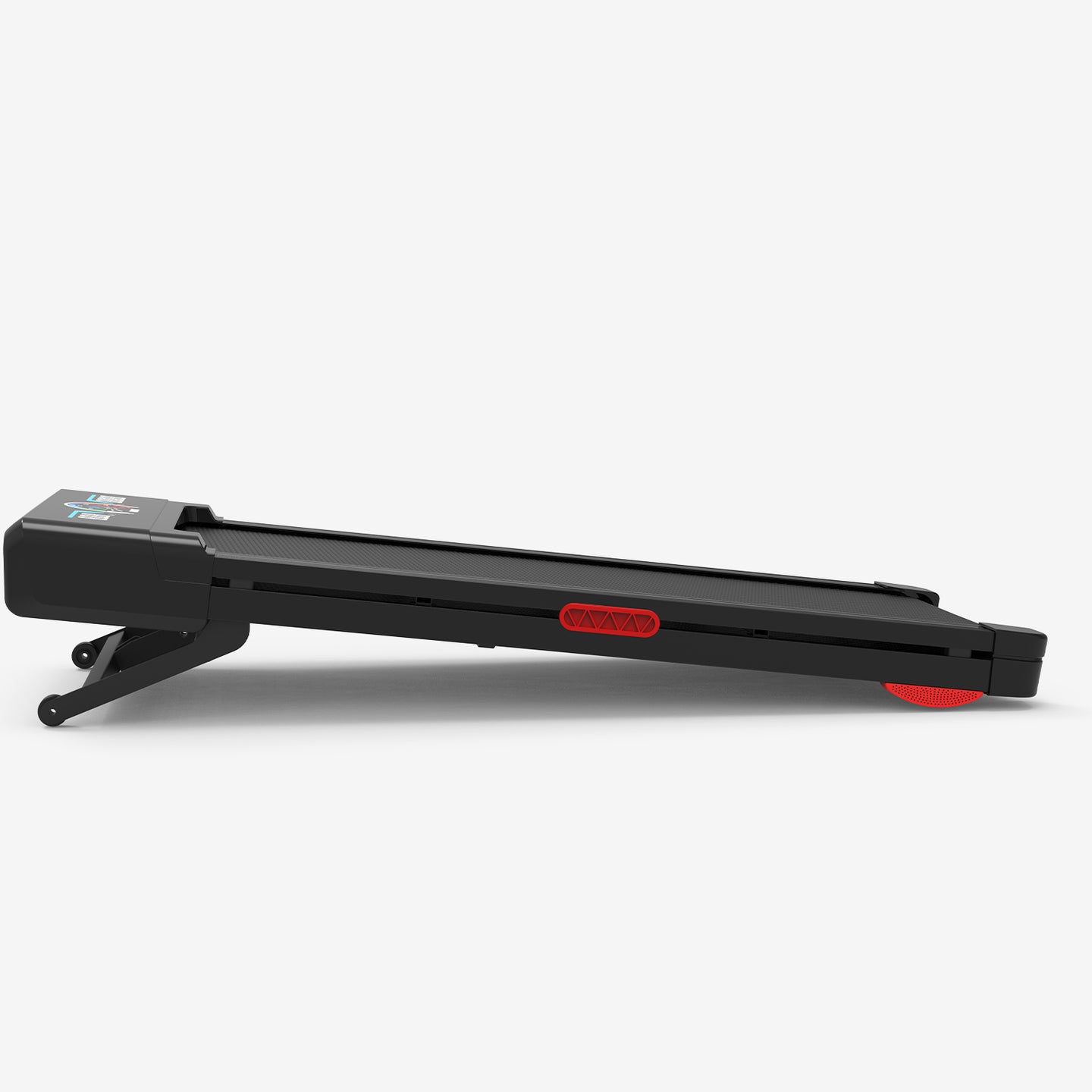HIIT Treadmill Workout

Don’t forget to check out our Pacerocker, Trailviber, and Trailviber Auto Incline walking pad treadmills.
High-intensity interval training (HIIT) on a treadmill is a game-changing workout that can transform your fitness routine. HIIT treadmill workouts combine short bursts of intense exercise with periods of rest or lower-intensity activity, maximizing calorie burn and improving cardiovascular health in less time than traditional steady-state cardio. We love how these workouts challenge our bodies and minds, pushing us to new limits while keeping boredom at bay.
By incorporating HIIT into our treadmill sessions, we're able to torch calories, boost our metabolism, and improve our endurance - all in a fraction of the time it takes to complete a long, slow jog. Plus, the variety of speeds and inclines keeps our muscles guessing, leading to better overall fitness gains. Whether we're seasoned runners or just starting our fitness journey, HIIT treadmill workouts offer a scalable and efficient way to reach our goals.
Key Takeaways
- HIIT treadmill workouts burn more calories in less time than steady-state cardio
- Alternating high-intensity intervals with rest periods improves cardiovascular fitness and endurance
- Proper form, gradual progression, and adequate recovery are essential for safe and effective HIIT training
What Is HIIT?
HIIT workouts combine short bursts of intense exercise with brief recovery periods. This approach maximizes calorie burn and improves cardiovascular fitness in less time than traditional workouts.
Defining High-Intensity Interval Training
HIIT stands for High-Intensity Interval Training. It's a workout method that alternates between intense bursts of activity and fixed periods of less-intense activity or rest. A typical HIIT session might last 20-30 minutes.
The "high-intensity" intervals should push you to 80-95% of your maximum heart rate. These bursts usually last 15 seconds to 3 minutes, depending on the specific workout.
Recovery periods allow your body to prepare for the next high-intensity interval. They can involve complete rest or low-intensity exercise, lasting about as long as the work periods.
HIIT can be applied to various exercises, including running, cycling, and bodyweight movements.
Historical Background
HIIT's roots trace back to the early 20th century. Finnish Olympic long-distance runner Hannes Kolehmainen used interval-style training in the 1910s to enhance his performance.
In the 1930s, Fartlek training, a precursor to modern HIIT, gained popularity among Swedish runners. This method involved alternating between fast and slow running paces.
The 1950s saw German coach Woldemar Gerschler refine interval training techniques for his athletes. His work laid the foundation for the scientific study of HIIT.
HIIT gained mainstream popularity in the 1990s and 2000s as research highlighted its effectiveness for fat loss and cardiovascular health.
Benefits of HIIT Treadmill Workouts
HIIT treadmill workouts offer numerous advantages for fitness enthusiasts. These high-intensity sessions can transform your exercise routine and deliver impressive results in less time.
Calorie Burning Efficiency
HIIT treadmill workouts are a powerhouse for calorie burning. We've found that these intense sessions can torch up to 25-30% more calories than steady-state cardio in the same amount of time.
The alternating bursts of high-intensity sprints and recovery periods create an "afterburn effect." This phenomenon, known as excess post-exercise oxygen consumption (EPOC), keeps our bodies burning calories for hours after the workout ends.
A typical 30-minute HIIT treadmill session can burn anywhere from 300-400 calories, depending on individual factors like weight and fitness level. This efficiency makes HIIT an excellent choice for those with busy schedules looking to maximize their workout time.
Cardiovascular Health Improvements
HIIT treadmill workouts significantly boost our cardiovascular health. These intense sessions strengthen our heart muscle and improve its ability to pump blood efficiently.
Regular HIIT practice can lead to:
- Lowered resting heart rate
- Improved blood pressure
- Enhanced oxygen uptake
- Increased stroke volume (amount of blood pumped per heartbeat)
Studies show that HIIT can be more effective than moderate-intensity continuous training in improving VO2 max, a key indicator of cardiovascular fitness. This translates to better endurance and overall heart health in our daily lives.
Metabolic Rate Increase
HIIT treadmill workouts are a game-changer for our metabolism. The intense nature of these sessions triggers a substantial increase in our metabolic rate, which persists long after we've stepped off the treadmill.
This elevated metabolism helps us burn more calories throughout the day, even when we're at rest. Research suggests that HIIT can increase our metabolic rate for up to 48 hours post-workout.
HIIT also promotes the production of human growth hormone (HGH) by up to 450% during the 24 hours after completion. HGH plays a crucial role in:
- Fat burning
- Muscle growth
- Slowing down the aging process
By incorporating HIIT treadmill workouts into our routine, we're not just burning calories during exercise - we're setting our bodies up for enhanced fat-burning and muscle-building potential around the clock.
Preparation for HIIT Treadmill Sessions
Getting ready for a HIIT treadmill workout involves several key steps. We'll cover essential safety measures, the equipment you'll need, and effective warm-up routines to maximize your session.
Safety Precautions
Before starting any HIIT treadmill workout, we need to prioritize safety. First, ensure the treadmill is in good working condition. Check that the belt moves smoothly and the emergency stop function works properly.
Wear appropriate footwear with good traction and support. Loose clothing can be hazardous, so opt for fitted workout gear. Keep a water bottle nearby to stay hydrated during intense intervals.
Start at a comfortable pace and gradually increase intensity. Listen to your body and stop if you experience pain or dizziness. It's crucial to maintain proper form throughout the workout to prevent injuries.
Equipment Overview
For HIIT treadmill sessions, we'll primarily use the treadmill itself. Most modern treadmills offer adjustable incline and speed settings, perfect for interval training. Some models have built-in HIIT programs, which can be helpful for beginners.
Additional equipment can enhance your workout:
- Heart rate monitor
- Towel for sweat
- Fitness tracker or stopwatch
Consider using a fan to keep cool during intense bursts. If your treadmill doesn't have a built-in entertainment system, bring your own music or podcasts to stay motivated.
Warm-Up Routines
A proper warm-up is essential for HIIT treadmill workouts. We recommend starting with 5-10 minutes of light cardio to increase heart rate and blood flow. Begin with a brisk walk, then transition to a light jog.
Include dynamic stretches to prepare your muscles:
- Leg swings (forward and side-to-side)
- Arm circles
- Hip rotations
- Ankle rolls
Gradually increase your pace during the warm-up. This prepares your body for the high-intensity intervals to come. End your warm-up with a few 10-second sprints at 70% effort, followed by 30 seconds of walking.
Designing Your HIIT Treadmill Program
Creating an effective HIIT treadmill workout requires careful planning of intervals, rest periods, and intensity levels. We'll explore how to structure your program for maximum results.
Understanding Interval Structures
HIIT treadmill workouts alternate between high-intensity bursts and recovery periods. A typical structure might include:
- 30 seconds sprint, 30 seconds recovery
- 1 minute high incline walk, 1 minute flat recovery
- 45 seconds sprint, 15 seconds rest
We can mix and match these intervals to create varied and challenging workouts. It's crucial to push ourselves during the high-intensity phases while allowing adequate recovery.
Work-to-Rest Ratios
The ratio of work to rest periods significantly impacts the workout's intensity. Common ratios include:
1:1 - Equal work and rest (e.g., 30 seconds sprint, 30 seconds rest) 2:1 - Twice as much work as rest (e.g., 40 seconds sprint, 20 seconds rest) 1:2 - Twice as much rest as work (e.g., 20 seconds sprint, 40 seconds rest)
We'll choose our ratio based on our fitness level and goals. Beginners might start with more rest, while advanced athletes can handle less recovery time.
Progression and Intensity Levels
To keep improving, we need to progressively increase the challenge of our HIIT treadmill workouts. We can do this by:
- Increasing sprint speed
- Raising incline during high-intensity intervals
- Lengthening work periods or shortening rest periods
- Adding more total intervals to the workout
It's important to listen to our bodies and increase intensity gradually. We might start with 15-20 minutes of HIIT and work up to 30-45 minutes as our fitness improves.
Sample HIIT Treadmill Workouts
Ready to rev up your treadmill routine? We've got exciting HIIT workouts for all fitness levels. These sessions will torch calories and boost your endurance in no time.
Beginner-Friendly Sessions
Start with a 5-minute warm-up walk at a comfortable pace. Then, alternate between 30 seconds of jogging and 30 seconds of walking for 10 rounds. This totals 10 minutes of intervals.
Finish with a 5-minute cool-down walk. As you build stamina, increase the jogging speed or extend the interval time to 45 seconds each.
Another beginner option: Walk at a brisk pace for 1 minute, then power walk or lightly jog for 30 seconds. Repeat this cycle 8-10 times.
Advanced Challenges
For seasoned runners, try this pyramid workout:
- 1-minute sprint, 1-minute recovery jog
- 2-minute sprint, 1-minute recovery
- 3-minute sprint, 1-minute recovery
- 2-minute sprint, 1-minute recovery
- 1-minute sprint, 1-minute recovery
Repeat the pyramid 2-3 times for a killer session. Always bookend with proper warm-up and cool-down periods.
Another intense option: 30-second all-out sprints followed by 30 seconds of rest. Repeat for 10-15 rounds.
Variations to Beat Boredom
Mix things up with incline intervals. Set the treadmill at a 5-8% grade for "hills" and return to flat for recovery periods. Try 1 minute uphill, 1 minute flat for 10-15 rounds.
Incorporate lateral shuffles to target different muscles. Face sideways on the treadmill at a slow speed. Shuffle for 30 seconds, then turn and repeat on the other side. Alternate with forward jogging.
Try a "commercial break" workout during TV time. Sprint during commercials and recover during the show. It's a fun way to stay engaged and push your limits.
Recovery and Post-Workout Care
Proper recovery after a HIIT treadmill workout is crucial for muscle repair, preventing injury, and maximizing fitness gains. We'll explore key aspects of post-workout care to help you bounce back quickly and safely.
Cool-Down Importance
A cool-down helps our bodies transition from intense exercise to a resting state. We recommend spending 5-10 minutes walking at a slow pace on the treadmill after your HIIT session. This gradual reduction in intensity allows our heart rate to return to normal and prevents blood from pooling in the legs.
Cool-downs also help flush out lactic acid, reducing muscle soreness. We've found that incorporating light stretches during this time can further enhance recovery. Remember to breathe deeply and stay hydrated during your cool-down routine.
Stretching and Flexibility
Post-workout stretching is essential for maintaining flexibility and reducing muscle tension. We suggest focusing on the major muscle groups used during your HIIT treadmill workout:
- Quadriceps
- Hamstrings
- Calves
- Hip flexors
- Lower back
Hold each stretch for 15-30 seconds without bouncing. Gentle dynamic stretches can also be beneficial. We've noticed improved recovery times and reduced stiffness when consistently incorporating stretching into our post-workout routine.
Monitoring Body's Response
Listening to our bodies after a HIIT treadmill workout is crucial. We pay attention to signs of excessive fatigue, unusual soreness, or prolonged recovery times. These can indicate the need for more rest or adjustments to our workout intensity.
Using a fitness tracker or heart rate monitor can help us track our recovery. We aim for our resting heart rate to return to normal within a few hours post-workout. Adequate sleep and proper nutrition also play vital roles in recovery.
If we experience persistent pain or discomfort, we don't hesitate to consult a healthcare professional or certified trainer for guidance.
Tracking Your Progress
Monitoring our HIIT treadmill workouts helps us stay motivated and see real improvements. We'll explore goal-setting, performance measurement, and program adjustments to maximize our results.
Setting Achievable Goals
Let's start by setting SMART goals for our HIIT treadmill sessions. Specific, Measurable, Achievable, Relevant, and Time-bound objectives keep us focused and driven.
For example, we might aim to increase our sprint speed by 0.5 mph every two weeks or boost our workout duration by 5 minutes monthly.
Remember, small, consistent gains lead to significant long-term progress. We'll write down our goals and review them regularly to stay on track.
Measuring Performance
Tracking key metrics allows us to quantify our improvements. Here are some essential parameters to monitor:
- Heart rate during sprints and recovery
- Sprint speed and duration
- Total workout time
- Calories burned
- Distance covered
We can use fitness apps, smartwatches, or even a simple notebook to record these stats after each session. Regularly comparing our numbers helps us visualize our progress and identify areas for improvement.
Adjusting the Program Based on Feedback
Our bodies adapt to exercise over time, so we need to tweak our HIIT treadmill workouts regularly. We'll pay attention to how we feel during and after sessions.
If we're consistently hitting our targets with ease, it's time to increase intensity. We can boost sprint speed, extend sprint duration, or shorten recovery periods.
On the flip side, if we're struggling to complete workouts, we might need to dial back the intensity temporarily. It's crucial to listen to our bodies and avoid overtraining.
Periodically reassessing our goals and adjusting our program keeps us challenged and progressing.
Nutrition and Hydration Tips
Proper fueling and hydration are crucial for maximizing the benefits of HIIT treadmill workouts. Let's explore key strategies to support your performance and recovery.
Fueling for HIIT Workouts
We recommend eating a balanced meal 2-3 hours before your HIIT session. Focus on complex carbohydrates and lean proteins. Good options include:
- Whole grain toast with avocado and eggs
- Greek yogurt with berries and granola
- Oatmeal with banana and almond butter
If you're short on time, opt for a light snack 30-60 minutes before exercising. Try a piece of fruit or a small energy bar.
During your workout, sip water regularly to stay hydrated. For longer sessions, consider a sports drink to replenish electrolytes.
Post-Workout Nutrition
After your HIIT treadmill workout, it's essential to refuel your body. Aim to eat within 30-60 minutes of finishing your session.
Your post-workout meal should include:
- Protein to repair muscles
- Carbohydrates to replenish energy stores
- Fluids to rehydrate
Some quick and effective post-workout snacks:
- Chocolate milk and a banana
- Protein shake with mixed berries
- Turkey and cheese sandwich on whole wheat bread
For a full meal, try grilled chicken with quinoa and roasted vegetables.
Hydration Strategies
Staying hydrated is crucial for HIIT performance and recovery. We suggest drinking water throughout the day, not just during workouts.
Pre-workout: Drink 16-20 oz of water 2-3 hours before exercise.
During workout: Sip 7-10 oz every 10-20 minutes.
Post-workout: Drink 16-24 oz for every pound of body weight lost during exercise.
Monitor your urine color - it should be pale yellow. If it's dark, you need to drink more water.
For intense or long sessions, consider electrolyte-rich drinks to maintain proper fluid balance.
Safety Considerations and Injury Prevention
HIIT treadmill workouts offer intense cardio benefits, but proper precautions are essential. We'll explore key safety aspects to help you maximize results while minimizing risks.
Recognizing Overtraining
Overtraining can derail progress and lead to burnout. Watch for these signs:
- Persistent fatigue
- Decreased performance
- Mood changes
- Frequent illness
If you experience these symptoms, it's time to scale back. We recommend reducing workout intensity or frequency for 1-2 weeks. Listen to your body and prioritize recovery.
Common Treadmill Injuries
Treadmill use comes with specific injury risks:
- Shin splints
- Knee pain
- Ankle sprains
- Lower back strain
Improper form or overuse often cause these issues. Gradually increase workout intensity to allow your body to adapt. Proper footwear and correct posture are crucial for injury prevention.
Injury Prevention Techniques
We can significantly reduce injury risk with these strategies:
- Warm up for 5-10 minutes before high-intensity intervals
- Cool down and stretch after workouts
- Maintain proper form: upright posture, relaxed shoulders
- Stay hydrated before, during, and after exercise
- Use the safety clip to prevent falls
- Keep treadmill area clear of objects
Regular equipment maintenance is also vital. Check belt tension and alignment monthly. Replace worn parts promptly to ensure safe operation.
Frequently Asked Questions
HIIT treadmill workouts offer an efficient way to boost fitness and burn calories. Let's address some common questions about incorporating these intense sessions into your routine.
How can beginners get started with HIIT treadmill workouts?
We recommend starting slow and building up gradually. Begin with a 5-minute warm-up at a comfortable pace. Then alternate 30 seconds of faster running with 90 seconds of recovery walking.
Repeat this cycle 5-6 times, followed by a 5-minute cool-down. As your fitness improves, increase the intensity and duration of the high-speed intervals.
What are the benefits of doing HIIT workouts on the treadmill?
HIIT treadmill workouts boost metabolism and improve cardiovascular fitness. They burn more calories in less time compared to steady-state cardio.
These workouts also enhance endurance and can be adapted for all fitness levels. The treadmill allows precise control over speed and incline, making it ideal for HIIT.
How long should a HIIT treadmill session last for effective weight loss?
A typical HIIT treadmill session for weight loss lasts 20-30 minutes. This includes a warm-up, 15-20 minutes of interval training, and a cool-down.
Consistency is key. Aim for 2-3 HIIT sessions per week, combined with a balanced diet for optimal results.
Can a 20 minute HIIT treadmill workout be sufficient for fat loss?
Yes, a 20-minute HIIT treadmill workout can be effective for fat loss. The high intensity of these workouts creates an afterburn effect, increasing calorie burn post-exercise.
For best results, ensure your intervals are truly high-intensity. Push yourself during the work periods, then recover fully during rest intervals.
How many calories can be burned during a 30-minute HIIT treadmill workout?
Calorie burn varies based on factors like weight, fitness level, and workout intensity. On average, a 30-minute HIIT treadmill session can burn 300-400 calories.
Some individuals may burn more, especially if they maintain very high intensities during work intervals. Remember, the afterburn effect adds to total calorie expenditure.
What intensity and incline settings are recommended for an optimal HIIT treadmill routine?
For high-intensity intervals, we suggest running at 80-90% of your maximum effort. This typically means a speed that you can maintain for only 30-60 seconds.
Incline can vary from 1-5% during work intervals. For recovery, reduce speed to a brisk walk and lower the incline. Adjust these settings based on your fitness level.
Maximize your fitness with our 20-minute HIIT treadmill workout! Burn calories, boost metabolism, and improve cardiovascular health efficiently.






